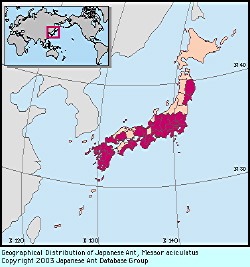
|
species
|
Messor aciculatus
|
 |
Japanese Name
|
Kuronaga-ari
|
Original Reference
|
|
Smith, F. (1874) Descriptions of new species of Tenthredinidae, Ichneumonidae, Chrysididae, Formicidae, &c. of Japan. Transactions of the Entomological Society of London (4) 7: 373-409.
|
Synonym
|
|
Aphaenogaster aciculata F. Smith, 1874,
Stenamma (Messor) aciculata: Forel, 1901,
Stenamma (Messor) aciculatum var. brunneicorne Forel, 1901,
Messor barbarus var. lobulifera Emery, 1901,
Aphaenogaster (Attomyrma) aciculata: Emery, 1921,
Messor aciculata: Forel, 1922,
|
Description
|
|
Total length of workers around 4 - 5 mm. Body color black. Head slightly longer than broad. Antennal scapes slightly surpassing posterior border of head. Long hairs absent from ventral surface of head, those present about as long as other body hairs. Metanotal groove rather deeply impressed and distinct both dorsally and laterally. Dorsal and declivitous faces of propodeum almost straight in lateral view, meeting at an angle of about 120 degrees, the junction rounded, without spines. Petiolar node nearly triangular in lateral view; postpetiolar node rounded. Tibial spurs of middle and hind legs simple. Almost all surfaces of body from mandibles to postpetiole rugose; the gaster entirely smooth and shining. Yellowish-white setae rather abundant over nearly the whole body.
|
Remarks
|
|
This species nests in bare areas near standing grasses and in open grasslands. Its nests open directly at the ground surface. Underground there is a nearly vertical shaft and many chambers; total nest depth may be up to 4 meters. In autumn workers collect grass seeds. Foraging workers show individual site tenacity: each returning repeatedly to search a particular area, though foraging methods vary according to food conditions. Winged sexuals fly from April to May (Onoyama, 1981a).
The number of larval instars is three (Onoyama, 1981; Onoyama, 1982a). Chromosomal number 2n=44 (Imai & Yosida, 1965). In Japan Messor aciculatus is distributed from Iwate Prefecture to Yaku Island. It is also found widely on the Asian continent (Onoyama, 1981).
|
|

Distribution
|
|
Honshu, Shikoku, Kyushu, Yaku I.; Mainland China, Korean Peninsula, Mongolia.
|
|
References
|
|
- Descriptions of new species of Tenthredinidae, Ichneumonidae, Chrysididae, Formicidae, &c. of Japan. Transactions of the Entomological Society of London (4) 7: 373-409.
- Forel, A. 1901. Formiciden des Naturhistorischen Museums zu Hamburg. Neue Calyptomyrmex-, Dacryon-, Podomyrma- und Echinopla-Arten. Mitt. Naturhist. Mus. Hambg., 18: 43-82.
- Emery, C. 1901. [Untitled. Descriptions of new taxa: Messor barbarus Linn. var. lobulifera Emery n. var.; Formica nasuta Nyl. subspec. mongolica Emery n. subspec.].
- Emery, C. (1921). Hymenoptera, fam. Formicidae, subfam. Myrmicinae. . In P. Wytsman, ed., ""Genera Insectorum"", fasc. , 174A, 1-94. .
- Forel, A. 1922. Glanures myrmcologiques en 1922. Rev. Suisse Zool., 30: 87-102.
- Kubota, M. (1948). Observations on the bahavior of Messor aciculatus. . Shin Kontyu, 1(6), 16-20.
- Taki, A. (1976). Colony founding of Messor aciculatum (Fr. Smith) (Hym. : Formicidae) by single and grouped queens. . Physiol. Ecol. Jpn., 17, 503-512.
- Onoyama, K. (1981b.). Brood rearing by colony founding queens of the harvester ant Messor aciculatus. . Kontyu, 49, 624-640.
- Onoyama, K. (1982b. ). Foraging behavior of the harvester ant Messor aciculatus, with special reference to foraging sites and diel activity of individual ants. . Jpn. J. Ecol., 32, 453-461.
- Onoyama, K. & T. Abe (1982). Foraging behavior of the harvester ant Messor aciculatus in relation to the amount and distribution of food. . Jpn. J. Ecol., 32, 383-393.
|
Editor
|
|
Original text by Keiichi Onoyama. English translation by Keiichi Onoyama, edited by Robert W. Taylor. Revised by Masashi Yoshimura.
|
|